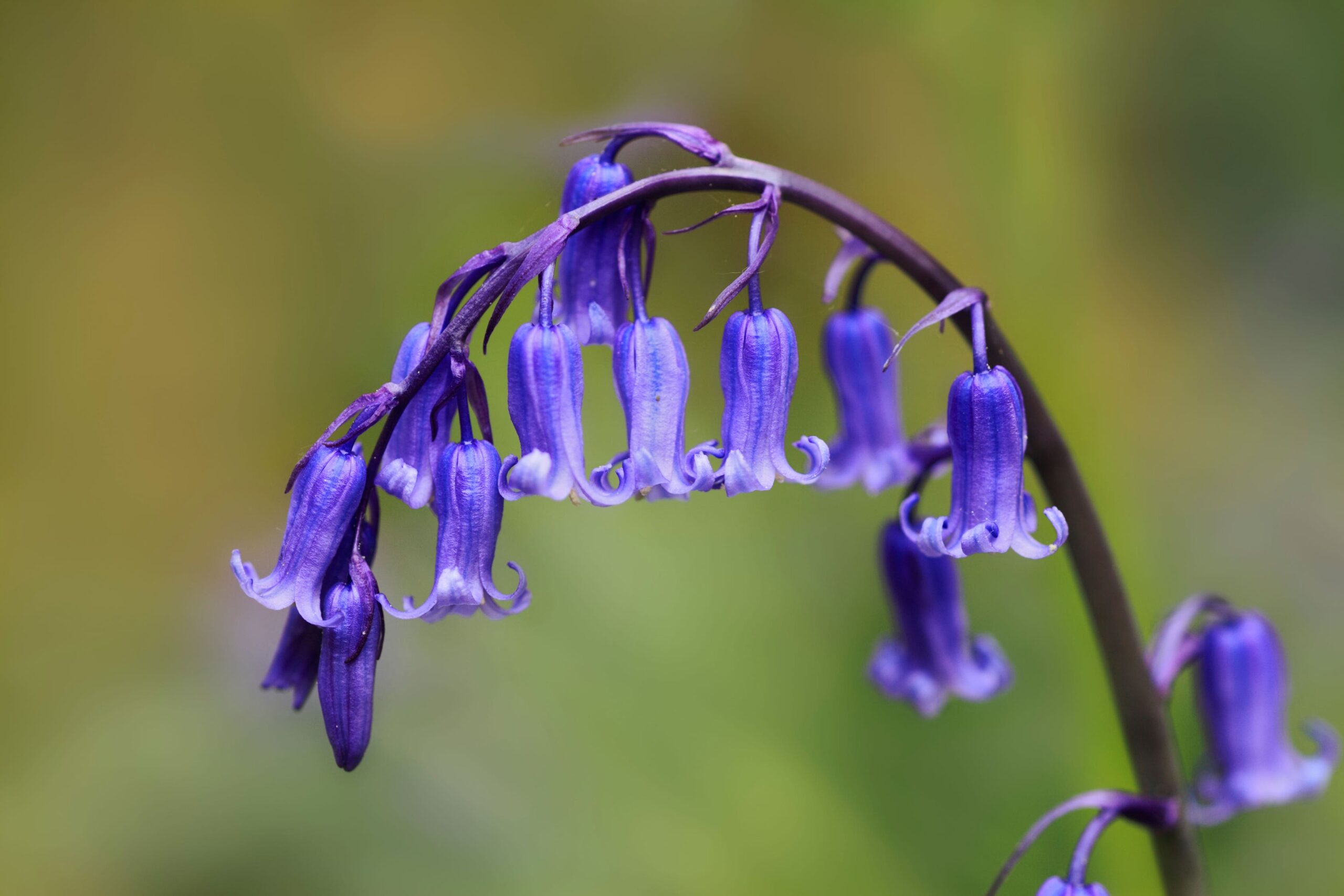Few sights capture the spirit of spring quite like a woodland carpeted in bluebells. Their delicate, nodding flowers seem to shimmer in dappled light, bringing a quiet beauty and ethereal charm to forest floors, cottage gardens, and shaded borders. Bluebells don’t shout—they enchant.
But behind their soft, fleeting appearance lies a tough and persistent plant that thrives with minimal care. Whether you’re growing native Hyacinthoides non-scripta or the more vigorous Spanish bluebell, these springtime charmers are an ideal way to welcome the season.

Portrait of the Bluebell
Bluebells belong to the Asparagaceae family and are renowned for forming dense colonies through underground bulbs. Native to Europe and the UK, they’ve long been celebrated in folklore, poetry, and conservation efforts.
- Type: Bulbous perennial
- Family: Asparagaceae
- Common Names: Bluebell, English Bluebell, Spanish Bluebell, Wood Hyacinth
Foliage and Form
Bluebells grow in graceful clumps with strap-shaped, arching leaves. Their slim stems bear one-sided clusters of hanging, bell-shaped flowers that gently nod downward, often forming masses in woodlands or shady borders.
- Height: 20–50 cm (8–20 in)
- Spread: 10–30 cm (4–12 in)
- Growth Habit: Clump-forming from bulbs, naturalizes easily
Blooms and Fragrance
Bluebells bloom in early to mid-spring, often before trees fully leaf out. Their soft blue to violet flowers are iconic, but pink and white varieties also occur. Native bluebells (H. non-scripta) are prized for their strong, sweet fragrance.
- Bloom Time: April to May
- Color: Blue, violet, white, or pink
- Fragrance: Sweet and honeyed, especially in native species
The Right Time to Plant, Prune, and Enjoy Bluebells
| Month | Planting | Flowering | Pruning |
|---|---|---|---|
| January | ❌ | ❌ | ✅ Remove old foliage |
| February | ❌ | ❌ | ✅ Light trimming if needed |
| March | ✅ Container-grown bulbs | ❌ | ✅ Tidy up beds |
| April | ❌ | ✅ Early bloom | ❌ |
| May | ❌ | ✅ Peak bloom | ✅ Deadhead if needed |
| June | ❌ | ✅ (late flush in cool zones) | ✅ Allow leaves to yellow |
| July | ❌ | ❌ | ✅ Let foliage die back naturally |
| August | ✅ Dry bulbs for fall planting | ❌ | ❌ |
| September | ✅ Plant bulbs outdoors | ❌ | ❌ |
| October | ✅ Best time to plant bulbs | ❌ | ❌ |
| November | ✅ Continue bulb planting | ❌ | ✅ Clean up garden debris |
| December | ❌ | ❌ | ✅ Light garden pruning |
✅ = Recommended ❌ = Not advised
Watering, Sunlight, and Environment for Bluebells
Watering
Bluebells require moist soil during active growth, especially in spring. Once they go dormant, watering should be reduced or stopped entirely.
- When to Water: During spring growth and bloom
- How Much: Keep soil lightly moist—not soggy
- Watch out for: Overwatering after flowering
Sunlight
Bluebells are adapted to partial shade, particularly beneath deciduous trees. They thrive in light-dappled areas but can tolerate more sun in cooler regions.
- Ideal Exposure: Partial shade to dappled sunlight
- Shady Sites: Perfect for naturalizing under trees
- Too Much Sun: Can cause foliage to scorch or blooms to fade quickly
Indoor vs Outdoor
Bluebells are not suited to indoor growing. They need seasonal temperature shifts and space to naturalize.
- Best Location: Woodland gardens, shaded borders, under deciduous trees
- Avoid: Containers or indoor settings long term
Temperature
Native to temperate zones, bluebells are cold-hardy and thrive in cool, moist spring conditions. They go dormant in summer, needing little care during that period.
- Optimal Range: 7–20°C (45–68°F)
- Hardiness Zones: USDA zones 4–8
- Protection Tip: Avoid disturbing dormant bulbs in summer
Ideal Soil Conditions for Growing Bluebells
| Soil Feature | Optimal Condition | Why It Matters |
|---|---|---|
| Soil Type | Loamy or clay-loam | Holds spring moisture without waterlogging |
| Texture | Soft, crumbly, and humus-rich | Mimics woodland floor |
| Drainage | Moist but well-draining | Prevents bulb rot |
| Moisture | Moist in spring; dry in summer | Follows natural dormancy cycle |
| Soil pH | Slightly acidic to neutral (6.0–7.0) | Supports healthy foliage and bloom |
| Fertility | Moderate | High fertility not needed; too much encourages leaf growth over flowers |
💡 Tip: Enrich soil with compost or leaf mold to mimic forest conditions.
Common Problems & Solutions
| Issue 🐾 | Symptoms 🔍 | Solutions 🛠️ |
|---|---|---|
| No Blooms 🌱 | Only leaves appear | Too much shade or overcrowding—divide bulbs |
| Yellow Leaves 🍂 | Premature foliage yellowing | Poor drainage or low nutrients—check soil |
| Bulb Rot 💧 | Mushy bulbs, foul smell | Improve drainage, avoid watering in dormancy |
| Invasive Spread 🌿 | Colonizing unwanted areas | Dig up and thin out clumps in fall |
| Fungal Leaf Spots 🍃 | Brown patches on leaves | Improve air circulation, remove affected foliage |
Bluebells offer a gentle kind of magic. With very little effort, they naturalize to create unforgettable spring displays year after year. Whether you’re filling a shaded garden path or restoring a woodland patch, bluebells bring charm, tradition, and ecological value to any outdoor space. And once they bloom, you’ll understand why poets, painters, and gardeners have adored them for generations.